Microsoft's latest efforts to shove Windows PCs back into relevance in the Post PC era have found willing volunteers among some PC bloggers ready to exchange their credibility for enthusiastic reviews of Surface Book and Pro 4, apparently under the premise that Windows can be reanimated back into a viable monopoly via hybrid Tablet PC-style convergence. But that's delusionally wrong, here's why.
Reality hits the Windows fan
Theoretically, Microsoft has the appearance of a cohesive strategy for maintaining Windows 10 as a universal cross platform architecture spanning desktop PCs, laptop-tablets, tablet-laptops, phones, huge conference room displays, and maybe wrist bands and HoloLens helmets.
However, the reality is that Windows is a legacy PC operating system with no significant consumer success to speak of outside of conventional desktop PCs, a market segment that has been rapidly abandoned by consumers migrating to mobile devices. The overwhelming, universal embrace of mobile devices has not been kind to Microsoft.The overwhelming, universal embrace of mobile devices has not been kind to Microsoft.
When Steve Jobs introduced iPad in 2010, Microsoft's fiscal year (ending in June) reported annual revenues of $18.5 billion (and earnings of $13 billion!) from its Windows Division, lush profit margins from a software monopoly that taxed the purchase of virtually every PC sold on earth to syphon off most of the profits of the PC industry into Microsoft's coffers.
Those results represented a revenue increase of 23.5 percent (and a 30 percent increase in profits) over Microsoft's fiscal 2009. However, over the next three years, Microsoft's Windows Division fell into a coma, with revenues increasing less than 3 percent for 2011 and then falling more than 3 percent for 2012 before "rebounding" by a meager 4 percent for 2013.
The PC market had stopped growing. Windows Division earnings fared even worse, collapsing from $13 billion in fiscal 2010 to $12.3 billion in 2011, to $11.6 billion in 2012 and $9.5 billion in 2013.
The company scrambled to rearrange its deck chairs the following year, somewhat obscuring its year-over-year Windows performance by redefining various operating segments, but it still outlined a free-fall in revenues from Windows "devices and consumer licensing" segment, which further plummeted from $19.43 billion for 2013 to $14.97 billion in 2015.
Under the slightly new reporting style, gross margins from "devices and consumer licensing" fell from $16.99 billion in 2013 to $13.87 billion in 2015, a drop of more than 18 percent over two years, following the Windows Division earnings drop of more than 26 percent over the first two years of iPad sales.
The secret failure of Windows
I bet you didn't know that Windows was performing so badly for Microsoft as a business segment. After all, nobody is reporting it, the same way that it's virtually a secret that Google's ads business is struggling with both lower growth in ad clicks and in the click rates it can charge advertisers. I bet you didn't know that Windows was performing so badly for Microsoft as a business segment
And yet investors were throwing money at both Google and Microsoft this week as both announced earrings that "beat" expectations. That's a relative term, because "expectations" pit companies against a composite of analysts' arbitrary hogwash, rather than some actual, fundamental performance standard.
Consider that Amazon was expected to lose money this quarter, so its paltry net earnings of $79 million on revenues of over $25 billion were hailed as a "strong beat," inducing investors to ratchet up the company's valuation by another $26 billion.
If you "expect" Apple to jump the moon while only "expecting" that Microsoft won't stab itself in the eye with a fork, Apple can "fail to beat" expectations while successfully entering a low earth orbit and Microsoft can "exceed expectations" by just stabbing itself in the wrist with said fork.
In fact, that's actually been happening since iPad first appeared; just look at all the fork marks in the body of Microsoft, which just laid off another 1,000 workers (not including the 7,800 it terminated earlier this year related to the failure of the Nokia Windows Phone group).
The much ballyhooed failure of iPad to grow
Given that Microsoft's Windows monopoly has been materially collapsing in the face of mobile devices, it's interesting that the "failure" label has more often been applied to Apple's iPad, which hasn't reported a year-over-year increase in unit sales since Q1 2014. Last winter, Apple reported sales of 21.4 million iPads, a decrease of 17 percent over the previous holiday quarter and a nearly 6.4 percent decline from 2013.
Obviously, Apple would prefer to sell more iPads every quarter. iPad unit sales and dollar earnings are down over the past two years on a scale similar to Microsoft's Windows. The difference is that iPad sales appear to have been eaten into by growing Mac and iPhone sales, while Windows has been eaten into by products that Microsoft doesn't sell. That's a key fact iPad-failuremongers fail to consider.
Another is the fact that when iPad first appeared in 2010, it was met with yawns and dismissive limp-handed gestures from most of the tech media. Nobody was predicting that iPads would rapidly shake the foundations of conventional PC industry, shifting RAM and hard drives into an inventory glut and severing the artery supplying Microsoft's budget earmarked for future liberal spending.
iPads ballooned into a greater than 50 million unit per year business for Apple, generating rich profits for the company even as its competitors gave away their own tablets in a desperate bid to ship anything at all, even as a loss leader. Essentially, iPad helped Apple freeze all growth the Windows PC industry, while scaling up its own computer sales from the 10 million Macs it had been selling per year to a combined 18 million Macs and 58 million iPads just five years later.
If you count PC sales like IDC (including tablets), that means Apple's computers sales increased 780 percent over five years. Once iPad sales took off, IDC had to start counting iPads separate from Macs (even while it counted PCs and Tablet PCs together) because it would otherwise not paint a flattering picture for its largest client.
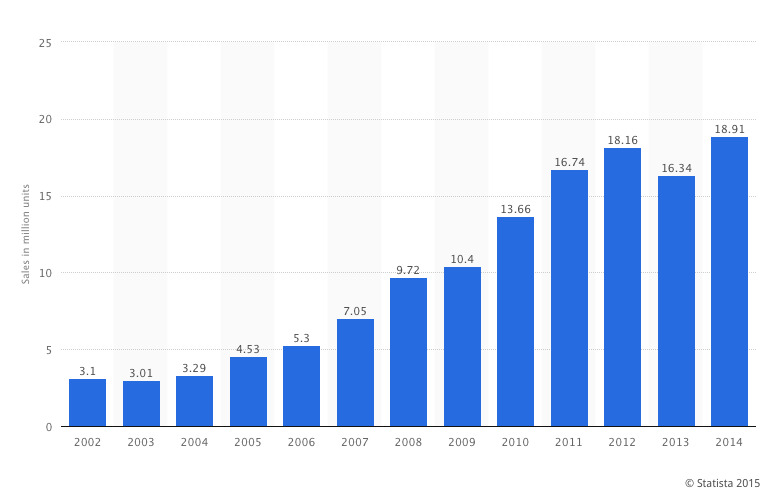 Mac sales. Source: http://www.statista.com/statistics/276308/global-apple-mac-sales-since-fiscal-year-2002/
Mac sales. Source: http://www.statista.com/statistics/276308/global-apple-mac-sales-since-fiscal-year-2002/
">Statistica
But rather than describing Apple's performance as the unprecedented, incredible coup that it is, tech industry pundits are still suggesting that Apple is in grave danger of shipping fewer volumes of a specific model of its computers, seeing a "trend" in just two years while apparently being completely blind to the clear history of OS X that's unfolded at Windows' expense over the past 15 years.
In calendar 2013, iPad sales reached record heights while Mac sales went down for the first time in a decade. The only imaginable way Apple could enhance its performance would be to shift around its mix of iPads and Macs so that it was selling more expensive Macs at the expense of volumes of lower end iPads... which it what it managed to pull off during 2014.
Meanwhile, the rest of the market continued selling fewer computing devices at lower Average Selling Prices, exemplifying how difficult it really is to shape the demand for your own products. Obviously, every business would prefer to sell more higher end products at higher prices, but the reality is that most buyers want to pay less and generally trend toward accepting a lower quality product to fit their budget. Apple has been expertly upselling buyers to luxury computing goods in a way that the overall PC market has simply been unable to accomplish. Apple has been expertly upselling buyers to luxury computing goods in a way that the overall PC market has simply been unable to accomplish
Further, the substitute products eating into iPad growth (remember that overall, Apple's unit sales and earnings have only gone up, so those iPads Apple "wasn't selling" were actually iPhones and Macs that it was) use the same development APIs and share the same developer ecosystem.
The Windows PC licensing business is eroding not to a river of Windows Mobile phones and Zunes, but to a torrent of cheap Androids, premium computing devices sold through Apple Retail and enterprise iOS devices sold by IBM.
Note, too, that Microsoft has shifted from selling Windows to consumers for around $200 per upgrade to a new model where the company begs PC users to download Windows 10 for free, even going so far as to install its new software without asking in many cases.
It's as if Microsoft is playing a PC game of Monopoly where it's now offering to let anyone land on Boardwalk for free, but nobody has noticed because we're all on our iPhones.
What if Microsoft released an iPad that ran Windows but nobody cared?
While the tech media hasn't been too worried about Microsoft's predicament, Microsoft itself has been. In 2011, a year into the onslaught wrought by iPad, the company unveiled plans to port Windows to mobile ARM chips in a bid to make its 1990's PC platform relevant on mobile devices.
Delivered nearly two years later, Windows RT flopped spectacularly, resetting Microsoft's strategy back to the year 2000 when Bill Gates predicted that the future of the desktop PC was a laptop PC in the form factor of a tablet device, where "tablet" meant a laptop held like a 3-ring binder notebook, paired with a basic stylus required to account for the fact that you can't really use a trackpad or a mouse on a PC tablet you hold like Moses.
Rather than copying Apple's super thin, simple to use, fully multitouch iPad, Microsoft refocused on new iterations of its own Surface Pro as a relatively thin PC laptop with a detachable keyboard, powered by a laptop Intel processor, which gave it full Windows compatibility and the battery life of a conventional PC laptop, at a price much higher than a conventional PC laptop.
Microsoft SurfaceWindows Surface also still needed a stylus to drive it because Windows PC desktop software is designed to be used with a precision pointing device like the mouse developed for Apple's Macintosh in 1984, or the trackpad introduced to the mainstream by Apple's PowerBook 500 in 1994, or a plastic stylus introduced for pen computing by Apple's Newton MessagePad that same year.
While Microsoft had belatedly copied Apple's OS X move to iOS by porting its Windows OS to ARM hardware for Surface (six years after Apple), it was far more difficult to transition the entire Windows user interface, its Office apps and the entire ecosystem of Win32 software to a modern, multitouch navigation convention in the manner Apple had with iPad. That meant that Surface needed to remain stuck in the 1990s with full reliance upon a keyboard and stylus or trackpad.
Further, the efforts Microsoft did make to shoehorn aspects of iPad-like multitouch into Windows were confusing and poorly implemented, resulting in a wholesale rejection of the new "Metro" LiveTile Windows appearance designed to facilitate a move toward what Apple had successfully accomplished by introducing iOS as a parallel, complementary experience next to OS X rather than a hybridized, master-of-none integration on the order of a refrigerator-toaster.
And yet, as with the Zune, Windows Phone and previous iterations of Surface, Microsoft's admirers have again applauded the company's late, copycat efforts while sidestepping around their showstopper flaws. The tech media's unnecessarily polite reception of the latest Surface Pro 4 and Book is no different, even after three previous generations of commercially unsuccessful failure offering a hint at how successful the latest crop will be.
WSJ: Surface Pro 4 is exciting because it's not from Apple
Writing for the Wall Street Journal, former Engadget blogger Joanna Stern stated that Microsoft's latest hybrid tablet/notebook Surface Pro 4 and its more laptop-oriented Surface Book (with a removable tablet-like display) "could be" an "answer to your prayers" if you're "jealous of Apple's best-in-class laptops" but a determined "Windows user."
"I love the unique, three-ring binder look," she wrote, before noting that "The design has some real flaws, though. The 3.3-pound, 0.9-inch-thick computer is chunkier than I'd like. And getting into it is like trying to crack a safe. The magnets that keep the system closed require you to throw too much back into it. Once you're in, there's a slight but unfortunate wobble in the display. This is related to that high-tech hinge that releases the screen when you press an eject key." "I love the unique, three-ring binder look. The design has some real flaws, though." - WSJ
The Surface Book trackpad "doesn't quite reach Apple's trackpad perfection," she added. "Sometimes my cursor would jump, stick or just disappear," problems that seem significant on a high end laptop in 2015, particularly one that needs a trackpad to run legacy Windows software because there's a dearth of modern iOS-like apps for Surface.
A key differentiating feature of the Surface line is its Surface Pen stylus, of which Stern complained that its "slight, unnatural writing delay made me yearn for a dead tree and a cheap Bic," before noting that its magnetic attachment "can easily fall off," a problem she blamed for losing the stylus in an airport, necessitating a $60 replacement.
While Windows Enthusiasts like to speak of the Surface Pen as an innovative feature, it's really just a flaw that Surface requires a stylus to functionally use it, due to the fact that legacy Windows software isn't multitouch and most people don't want to sharpen their finger down into a pencil tip shape in order to select targets designed for a mouse pointer. It's not something you can use; it's something you have to use.
Surface Book tries to get away from the hybrid neither-fish-nor-foul character of the tablet-laptop design of Surface Pro by flopping toward the laptop tank, ending up as a more conventional laptop you can transform into a tablet by removing the screen. That's not a new wrinkle in the PC space, and many transforming portables have failed since the first crop of Tablet PC dreamed them up fifteen years ago. But Surface Book is still hamstrung by Windows legacy, even without purporting to be a practical iPad alternative.
Describing some maddening Windows-style frustrations, Stern complained that the Surface Book's "display driver crash alert repeatedly interrupted my work, and twice the thing rebooted on its own, causing me to lose unsaved notes. (Other reviewers told me they had similar issues.)"
As a tablet, the Surface Book only lasted for 2.5 hours, she noted, compared to 10 hours for an iPad or MacBook Pro. The more tablet-like Surface Pro 4 "lasted just shy of six hours in tablet mode." So Surface Book is much worse as a tablet than Surface Pro, which was already not competitive as an iPad alternative. How much praise can be bestowed upon this clown-show of tone deaf consumer product engineering?"I can't recommend you get the new Surfaces, no matter how much I really loved using the Book when it was working correctly" - WSJ
After paragraphs that called various aspects of the new Surface products awkward, unpolished and straight up failing (due to faulty solid state drives Microsoft promised would be fixed before the new models went on sale), Stern wrote, "I can't recommend you get the new Surfaces, no matter how much I really loved using the Book when it was working correctly," adding that "If Microsoft fixes the glitches, it would be the Windows world's leading laptop."
So many products can claim to be the best if you make excuses for their "glitches." Just ask Stern's old employer the Verge, which has applauded model after model of Google Nexus devices while valiantly leaping over mountains of showstopper hardware flaws and major software bugs to award virtually every Google-branded Android import an enthusiastically high score independent of its engineering failings and coding flaws.
Up is down, Bill Gates invented the tablet and it evolved into a laptop
While readers regarded the Wall Street Journal review as both "funny" and "abject cluelessness" ("Despite the fact that the thing doesn't work, it's the best she's ever used? This is how the esteemed WSJ replaced the great Walt Mossberg?" asked Bud Youkers), the real intent of the piece seemed to be congratulating Microsoft for leading the world to tablets before iPad, and away from them ever since.
In a professional looking graphic attached to the piece (below), the Wall Street Journal presented "The Evolution of the Tablet," depicting a more ignorant impression of the definition of "evolution" than school textbooks commissioned by Texas.
The graphic suggests that laptops of the 1990s (depicted by a PowerBook 100 from 1991) evolved into Windows Tablet PCs a decade later. "In 2001, Bill Gates touted the benefits of a swiveling screen and a magical pen to navigate and write," the caption states, omitting that generations of tablets (like the four years of Newton Message Pads sold by Apple through 1998) were the real ancestors of Tablet PCs, both of which branched off from laptops and ambled off into extinction because they simply weren't fit for survival.
Jumping ahead to 2010, the graphic depicts Apple's iPad as a descendant of Tablet PC (apparently because Microsoft had so much functional mobile DNA and Apple didn't?) before suggesting that iPads have already evolved into "tablet-laptops" like the Surface and Apple's as yet unreleased iPad Pro. That sets up a future fantasy of "tablet-laptops" conveniently evolving into "laptop-tablets" like the Surface Book, the "unrecommendable/world-leading" new Post-Post-PC messiah.
The problem with this sort of historical revisionism presented as Lysenkoism-like pseudoscience is that none of it is remotely true. It's just pure flattery of Microsoft's sloppy attempts to direct the future of the market, attached to a supposition that the clumsy hybrid computing tools that Microsoft hopes users will buy this time around are more closely linked with Apple's unrelated successes than Microsoft's own genetically identical failures that it repeatedly floated over the past two decades.
Tablet PC devices didn't shape the world's use of technology. They played an extremely minor role among people desperately trying to find some use for them and for some excuse to pay lots of money for a product that didn't deliver as much value as a much lower priced conventional notebook.
Apple's iPad, on the other hand, isn't just a Mac with some gimmicky hardware tweaks. It's much more portable, more affordable and has a longer lasting battery, and offers an experience that is more broadly accessible to a larger audience, making it relevant to both younger and older demographics than conventional computers.
That's worthy of depiction as an evolutionary branch in mobile technology, but it certainly didn't evolve from Tablet PCs as it shares none of the flawed DNA that fated Bill Gates' vision for tablets to flounder towards extinction despite so many billions of dollars pushing it at consumers year after year.
iPad didn't evolve from Tablet PC; it competed against it and immediately drove it into extinction. In its first year, Apple sold more units than all of Microsoft's Tablet PC vendors combined had over the previous decade. Today, Apple sells another four times that many iPads every year.
Samsung's Q1 "UMPC" Tablet PC was a tweaked laptop, not an iPad ancestorOn the other hand, adding a removable screen to conventional notebook is not a brilliant new development: it's more of the same Tablet PC gadgetry in search of some market that might buy it, like Samsung watches or virtually anything electronic made by Sony in the 2000s. A lot of work went into it, but there's no clear reason why anyone would want to buy Surface Book, even if Microsoft does ever get around to fixing it before canceling the experiment like another Zune or Courier or KIN.
Almost worse, the Wall Street Journal piece appears intent to imply that Apple is chasing the strategies of Microsoft by releasing iPad Pro as a "tablet laptop." But really, nowhere in Apple's presentation of iPad Pro is it suggested that the new, larger iPad is now a hybrid notebook "trying to compete" with Surface Pro or Surface Book or any other crippled freak of engineering frankensteined together with Tablet PC body parts and splices of Windows 2000 DNA.
Apple's introduction video consistently portrays iPad Pro as a large iPad, noting only momentarily that its Apple Pencil can be used to draw with precision on the screen. Nothing in the user interface is based around Apple Pencil, and there's no trappings of Macintosh mouse legacy scurrying around expectant of a non-finger stylus touchdown event. Instead, it begins by emphasizing that iPad Pro is firmly centered around multitouch.
As for its presentation as a "laptop" by way of its Smart Cover keyboard option, iPads have been featured with directly connected and Bluetooth keyboards since they first appeared. The new iPad Pro debuts a new way to attach a keyboard or other peripheral directly, but connecting a keyboard via a proprietary connector is not exactly a brilliant invention Apple had to derive from a Samsung-like study in how to copycat Microsoft products.
New MacBook, iPad Pro show no signs of "convergence"
In reality, iPad Pro actually represents an evolution of Apple's optimization of the mix and scope of computing devices it sells.
This year, Apple introduced a new 12 inch Retina MacBook model (below) that is effectively a premium MacBook Air. It makes no effort to act or work like an iPad, but instead carries forward an enhanced evolution of the lightness and thinness that made MacBook Air a popular notebook (and which incited massive efforts by Microsoft and Intel to induce their partners to copy it in the Ultrabook program).
On the other hand, the 12.9 inch screen of the iPad Pro is being introduced as a premium iPad experience, giving buyers a choice between an $800-1,000 iPad Pro or the $1,300-1,600 MacBook, rather than some converged device purporting to perform two roles equally well for every demographic and task out there.
That's not even mentioning that Microsoft's tablet-laptop Surface Pro 4 costs $900-1,800 and its laptop-tablet Surface Book is stratospherically priced at $1,500-3,200. Microsoft would love to sell computers that cost more than Apple, just like it expected to sell Zunes that cost more than iPod and Lumia phones priced higher than an iPhone.
But the reality is that Microsoft can't sell much of anything to consumers anymore, and its Windows PC products compete even more directly with those from its Windows licenses, which have been scraping the bottom of the barrel for decades with ever cheaper, commodity hardware designed to run Windows.
Rather than trying to push converged devices at a hybrid-premium price, Apple actually emphasizes the differences between its iPads and Macs: they have different screen ratios and resolutions, and despite sharing much of their underlying operating system software and development tools Apple speaks of OS X and iOS as if they were colleagues rather than brothers.
They are also not intended to run the same software, because as Java, Android and the web have shown, "write once, run everywhere" results in third rate solutions in comparison to building custom apps optimized and tailored to the device they're intended to run on.
Apple isn't in any way following Microsoft's path of blending together every imaginable form factor of computing device into a smooth gradient of "PC" puree, and claiming it to be a cure all for whatever ails you, as long as it has Intel inside and is running Microsoft software.
Samsung's similar strategy of shooting all sorts of mobile screen sizes and form factors at the wall to see which ones might stick has similarly "converged" the definition of phone and tablet (coining the gagging term "fablet"), an "innovation" that market pundits once hailed as brilliant.
However, this has turned out to be nothing more than free market research for Apple, allowing it to squarely and precisely target consumer demand with a few expert sniper shots that ended up bagging over 90 percent of the handset industry's profits while expending only a tiny fraction of ammunition being sprayed into the market by its competitors.
Microsoft is bringing a convergence butter knife to a platform gun fight.
 Daniel Eran Dilger
Daniel Eran Dilger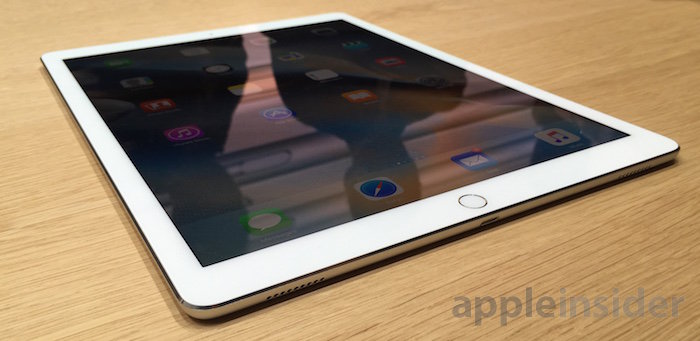
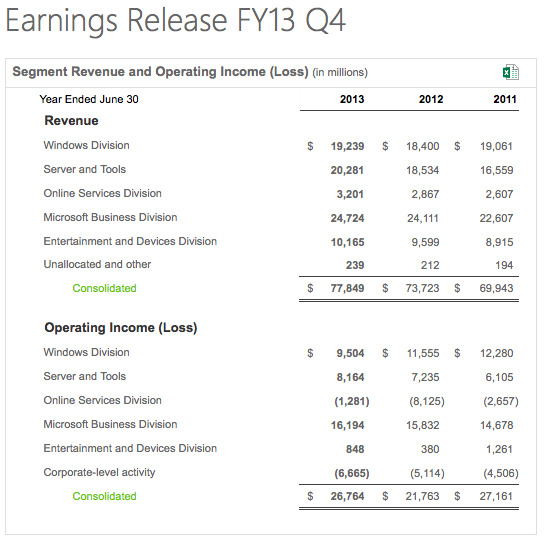
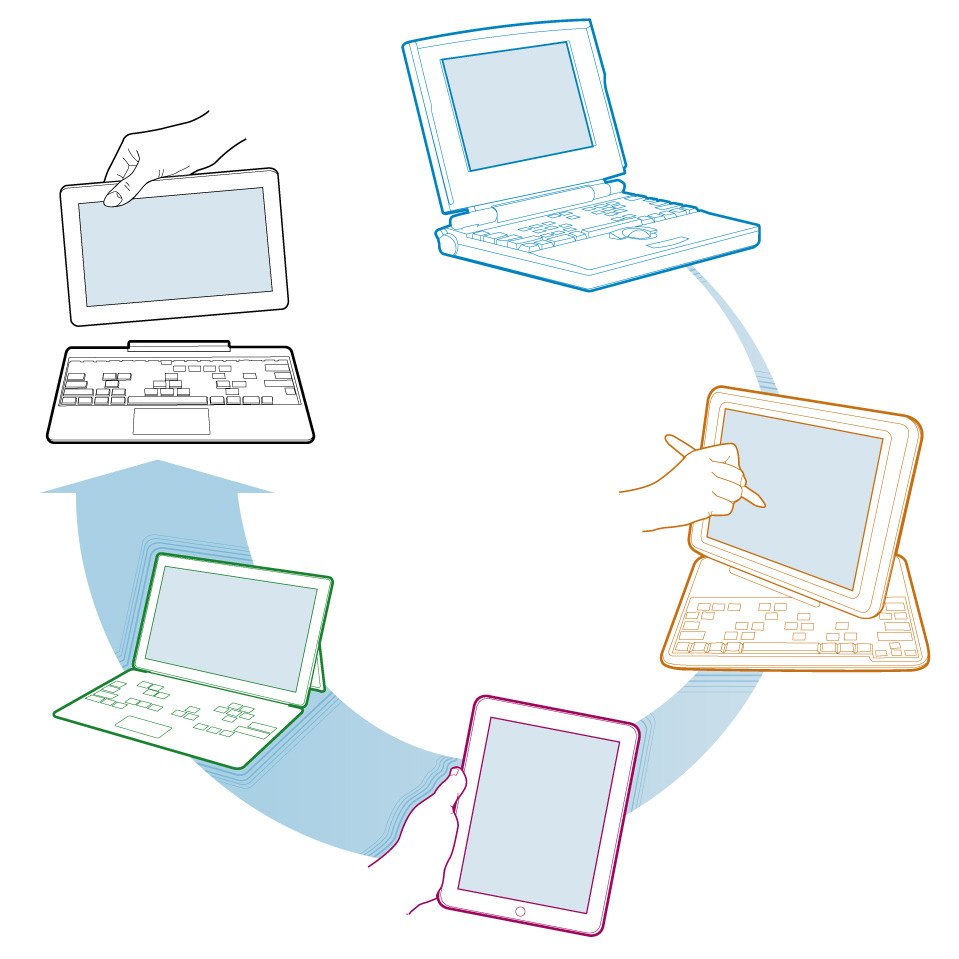


-m.jpg)






 Marko Zivkovic
Marko Zivkovic
 Mike Wuerthele
Mike Wuerthele
 Christine McKee
Christine McKee
 Amber Neely
Amber Neely
 Wesley Hilliard
Wesley Hilliard

 William Gallagher
William Gallagher


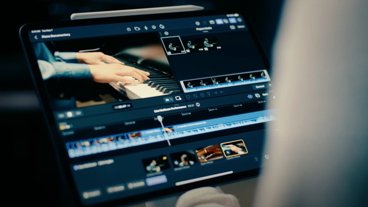







399 Comments
I see a kernel-up rewrite of OS X into OS XI (desktop multitouch) at some point before 2020. From that, iOS would be modified to be based in the OS XI base and exist as the OS on the iPhone and smaller iPads. Whether the iPad Pro gets OS XI will depend on things no one can envision yet.
Laptops? Dead. Mouse? Dead. No need for “convergence” or products halfway between uses.
[quote name="Tallest Skil" url="/t/189736/apple-resists-macbook-ipad-pro-convergence-as-microsoft-struggles-with-surface-windows-10-hybrids#post_2795797"]I see a kernel-up rewrite of OS X into OS XI (desktop multitouch) at some point before 2020. From that, iOS would be modified to be based in the OS XI base and exist as the OS on the iPhone and smaller iPads. Whether the iPad Pro gets OS XI will depend on things no one can envision yet.[/QUOTE] The rewrite will likely be Swift, and hopefully happens before 2020, but I don't think we need it to be call OS XI for that to happen. [QUOTE]Laptops? Dead. Mouse? Dead. No need for “convergence” or products halfway between uses.[/quote] Just because the sedan is popular doesn't mean trucks no longer exist. This isn't a "one has to die for the other to exist situation" and I don't see Xcode being made into a Cocoa Touch-only UI.
"
I see a kernel-up rewrite of OS X into OS XI (desktop multitouch) at some point before 2020. From that, iOS would be modified to be based in the OS XI base and exist as the OS on the iPhone and smaller iPads. Whether the iPad Pro gets OS XI will depend on things no one can envision yet.
Laptops? Dead. Mouse? Dead. No need for “convergence” or products halfway between uses.
I look at it from the other way - that iOS is the foundation / future for Apple and it will "scale up" to handle laptop / desktop use cases. Just like iOS can handle the specific UI cases for Watch, TV, iPhone, iPad, so too, it will do the same for future Apple devices. OSX is an excellent workstation OS for specialized tasks. I don't see that changing anytime soon.
[quote name="AppleInsider" url="/t/189736/apple-resists-macbook-ipad-pro-convergence-as-microsoft-struggles-with-surface-windows-10-hybrids/0_100#post_2795793"] On the other hand, adding a removable screen to conventional notebook is not a brilliant new development: [i]it's more of the same Tablet PC gadgetry in search of some market that might buy it, like Samsung watches or [b]virtually anything electronic made by Sony in the 2000s. [/b][/i][/quote] I giggled quite a bit at that line. And I'd argue that it's still the case with the exception of the PlayStation line. [quote name="AppleInsider" url="/t/189736/apple-resists-macbook-ipad-pro-convergence-as-microsoft-struggles-with-surface-windows-10-hybrids/0_100#post_2795793"] However, this has turned out to be nothing more than free market research for Apple, allowing it to squarely and precisely target consumer demand with a few expert sniper shots that ended up bagging over 90 percent of the handset industry's profits while expending only a tiny fraction of ammunition being sprayed into the market by its competitors. [/quote] This is my other favourite line from the article. The idea of Apple being an expert mercenary a la Hitman: Agent 47 while the others are some sort of bumbling henchmen just fills me with so much thrill and schadenfreude, mostly because of how accurate it seems to be.